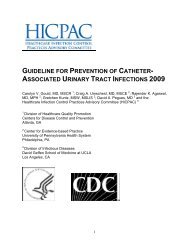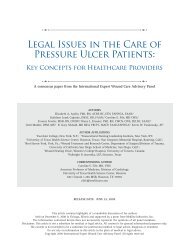SECT2.05 - Recommended Practices for Electrosurgery - Medline
SECT2.05 - Recommended Practices for Electrosurgery - Medline
SECT2.05 - Recommended Practices for Electrosurgery - Medline
- No tags were found...
You also want an ePaper? Increase the reach of your titles
YUMPU automatically turns print PDFs into web optimized ePapers that Google loves.
RP: <strong>Electrosurgery</strong>should be removed from service andthe active and dispersive electrodesretained if possible. 102Retaining the ESU, the active and dispersiveelectrodes, and packaging allows<strong>for</strong> a complete systems check to determineelectrosurgical system integrity. 102XIII.a.2. Incidents of patient or personnel electricalinjury or equipment failureshould be reported as required by regulationto federal, state, and localauthorities and to the equipment manufacturer.102 Device identification, maintenanceand service in<strong>for</strong>mation, aswell as adverse event in<strong>for</strong>mationshould be included in the report fromthe practice setting.Documentation of details of the electrosurgicalequipment and suppliesallows <strong>for</strong> retrievable in<strong>for</strong>mation <strong>for</strong>investigation into an adverse event. 102XIII.b. Policies and procedures <strong>for</strong> electrosurgeryshould include, but are not limited to thefollowing:– safety features required on ESUs;– equipment maintenance programs;– required supplemental safety monitors;– equipment checks be<strong>for</strong>e initial use;– reporting and impounding malfunctioningequipment;– reporting of injuries;– preoperative, intraoperative, and postoperativepatient assessments;– precautions during use;– ESU sanitation; and– documentation.XIII.c. An introduction and review of policies andprocedures <strong>for</strong> electrosurgery should beincluded in orientation and ongoing educationof personnel to assist in the developmentof knowledge, skills, and attitudes thataffect surgical patient outcomes.Review of policies and procedures assistshealth care professionals in the developmentof knowledge, skills, and attitudes thataffect patient outcomes.XIII.d. A written fire prevention and managementpolicy and procedure should be developedby a multidisciplinary group that includesall categories of perioperative personnel. 18,36Fire is a risk to both patients and healthcare workers in the perioperative setting.XIII.d.1. The policy and procedure shouldde scribe processes to be implementedto safely manage different fire scenarios.Recommendation XIVA quality assurance/per<strong>for</strong>mance improvement processshould be in place that measures patient, process,and structural (eg, system) outcome indicators.A fundamental precept of AORN is that it is theresponsibility of professional perioperative registerednurses to ensure safe, high-quality nursingcare to patients undergoing surgical and invasiveprocedures. 103XIV.a. Structure, process, and clinical outcomesper<strong>for</strong>mance measures should be identifiedthat can be used to improve patient careand that also monitor compliance withfacility policy and procedure, national standards,and regulatory requirements. 104XIV.a.1. Process indicators may include, but arenot limited to in<strong>for</strong>mation about adversepatient outcomes and near misses associatedwith electrosurgery, which shouldbe collected, analyzed, and used <strong>for</strong>per<strong>for</strong>mance improvement. 103XIV.b. Electrosurgical devices should be testedbe<strong>for</strong>e initial use, inspected periodically,and receive preventive maintenance by adesignated individual responsible <strong>for</strong> equipmentmaintenance (eg, biomedical engineeringservices personnel). 19Periodic preventative maintenanceensures continued safe operation of electrosurgicaldevices. 19XIV.c. Each ESU should be assigned an identificationor serial number.This number allows designated personnelto track function problems and documentmaintenance per<strong>for</strong>med on individual ESUs.XIV.d. Each health care organization should beresponsible <strong>for</strong> staying abreast of evolvingtechnology that may impact patient careand safety.Electrosurgical technology continues toevolve, changing the way in which surgicalhemostasis is achieved.2012 Perioperative Standards and <strong>Recommended</strong> <strong>Practices</strong> Equipment and Product Safety 113
















